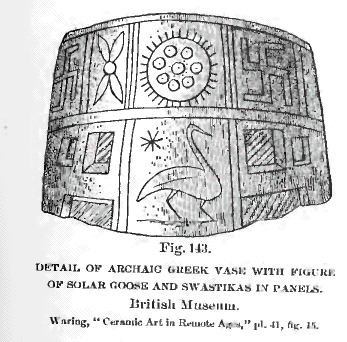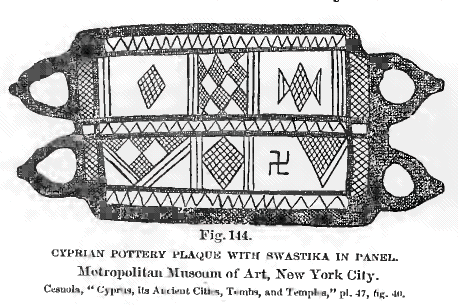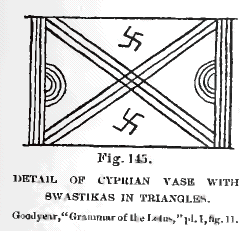

The Swastika
Dispersion of the Swastika
 the
Greek fret; but this is doubtful and surely has not been proved. It is
difficult, if not impossible, to procure direct evidence on the proposition.
Comparisons may be made between the two signs; but this is secondary or
indirect evidence, and depends largely on argument. No man is so poor
in expedients that he may not argue. Goldsmith's schoolmaster "e'en
tho' vanquished, he could argue still." The Greek fret, once established,
might easily be doubled or crossed in some of its members, thus forming
a figure similar to the Swastika (fig.
139), which would serve as an ornament, but is without any of the
characteristics of the Swastika as s symbol. The crossed lines in the
Greek fret seem to have been altogether fortuitous. They gave it no symbolic
character. It was simply a variation of the fret, and at best was rarely
used, and like it, was employed only for ornament and not with any signification
--- not a sign of benediction, blessing, or good luck, as was the Swastika.
The foundation principle of the Greek fret, so far as we can see its use,
is its adaptability to form an extended ornamental band, consisting of
doubled, bent, and sometimes crossed or interlaced lines, always
the
Greek fret; but this is doubtful and surely has not been proved. It is
difficult, if not impossible, to procure direct evidence on the proposition.
Comparisons may be made between the two signs; but this is secondary or
indirect evidence, and depends largely on argument. No man is so poor
in expedients that he may not argue. Goldsmith's schoolmaster "e'en
tho' vanquished, he could argue still." The Greek fret, once established,
might easily be doubled or crossed in some of its members, thus forming
a figure similar to the Swastika (fig.
139), which would serve as an ornament, but is without any of the
characteristics of the Swastika as s symbol. The crossed lines in the
Greek fret seem to have been altogether fortuitous. They gave it no symbolic
character. It was simply a variation of the fret, and at best was rarely
used, and like it, was employed only for ornament and not with any signification
--- not a sign of benediction, blessing, or good luck, as was the Swastika.
The foundation principle of the Greek fret, so far as we can see its use,
is its adaptability to form an extended ornamental band, consisting of
doubled, bent, and sometimes crossed or interlaced lines, always

 Swastika
fails. A row or band of Swastikas can not be made by continuous lines;
each one is and must be separated from its fellows. The Swastika has four
arms, each made by a single line which comes to an end in each quarter.
This is more imperative with the meander Swastika than with the normal.
If the lines be doubled on each other to be carried along to form another
Swastika adjoining, in the attempt to make a band, it will be found impossible.
The four lines from each of the four arms can be projected, but each will
be in a different direction, and no band can be made. It is somewhat difficult
to describe this, and possibly not of great need. An Attempt to carry
out the project of making a band of Swastikas, to be connected with each
other, or to make them travel in any given direction with continuous lines,
will be found impossible. Professor Goodyear attempts to show how this
is done by his figure on page 96, in connection with pl. 10, fig. 9, also
figs. 173 and 174 (pp. 353 and 354). These figures are given in this paper
and are, respectively, Nos. 21,
25, 26,
and 27. Exception is taken to
the pretended line of evolution in these figures: (1)
There is nothing to show any actual relationship between them. There is
no evidence that they agreed either in locality or time, or that there
was any unity of thought or design in
Swastika
fails. A row or band of Swastikas can not be made by continuous lines;
each one is and must be separated from its fellows. The Swastika has four
arms, each made by a single line which comes to an end in each quarter.
This is more imperative with the meander Swastika than with the normal.
If the lines be doubled on each other to be carried along to form another
Swastika adjoining, in the attempt to make a band, it will be found impossible.
The four lines from each of the four arms can be projected, but each will
be in a different direction, and no band can be made. It is somewhat difficult
to describe this, and possibly not of great need. An Attempt to carry
out the project of making a band of Swastikas, to be connected with each
other, or to make them travel in any given direction with continuous lines,
will be found impossible. Professor Goodyear attempts to show how this
is done by his figure on page 96, in connection with pl. 10, fig. 9, also
figs. 173 and 174 (pp. 353 and 354). These figures are given in this paper
and are, respectively, Nos. 21,
25, 26,
and 27. Exception is taken to
the pretended line of evolution in these figures: (1)
There is nothing to show any actual relationship between them. There is
no evidence that they agreed either in locality or time, or that there
was any unity of thought or design in figs. 146, 147, 148 ,149, 150
ENDNOTES:
1. Goodyear, "Grammar of the Lotus," pl. 61, fig. 1. [Back]
<< Previous Page Next Page >>
© 2004-2007 Northvegr.
Most of the material on this site is in the public domain. However, many people have worked very hard to bring these texts to you so if you do use the work, we would appreciate it if you could give credit to both the Northvegr site and to the individuals who worked to bring you these texts. A small number of texts are copyrighted and cannot be used without the author's permission. Any text that is copyrighted will have a clear notation of such on the main index page for that text. Inquiries can be sent to info@northvegr.org. Northvegr™ and the Northvegr symbol are trademarks and service marks of the Northvegr Foundation.

|